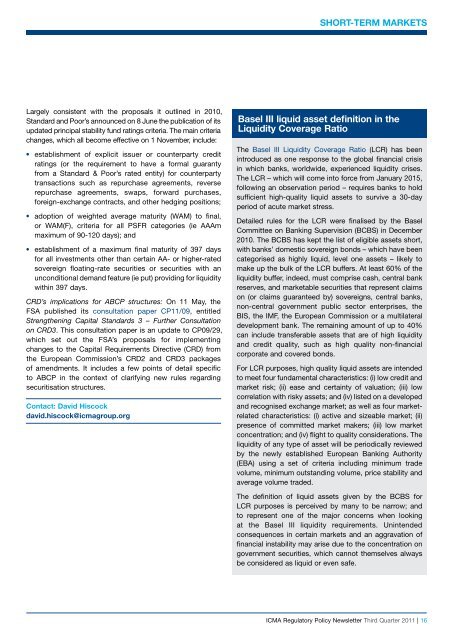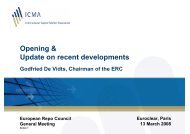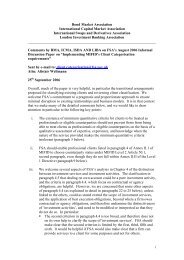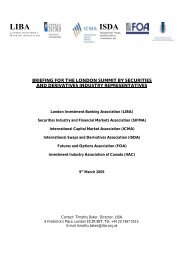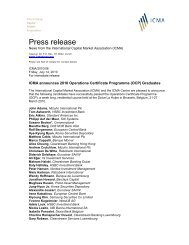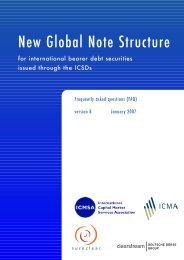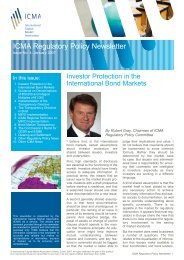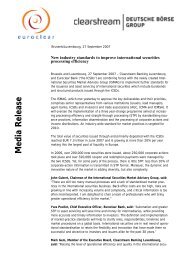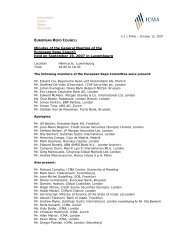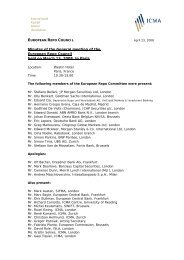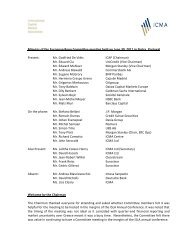Issue no. 22: ICMA Regulatory Policy Newsletter
Issue no. 22: ICMA Regulatory Policy Newsletter
Issue no. 22: ICMA Regulatory Policy Newsletter
You also want an ePaper? Increase the reach of your titles
YUMPU automatically turns print PDFs into web optimized ePapers that Google loves.
Largely consistent with the proposals it outlined in 2010,<br />
Standard and Poor’s an<strong>no</strong>unced on 8 June the publication of its<br />
updated principal stability fund ratings criteria. The main criteria<br />
changes, which all become effective on 1 November, include:<br />
• establishment of explicit issuer or counterparty credit<br />
ratings (or the requirement to have a formal guaranty<br />
from a Standard & Poor’s rated entity) for counterparty<br />
transactions such as repurchase agreements, reverse<br />
repurchase agreements, swaps, forward purchases,<br />
foreign-exchange contracts, and other hedging positions;<br />
• adoption of weighted average maturity (WAM) to final,<br />
or WAM(F), criteria for all PSFR categories (ie AAAm<br />
maximum of 90-120 days); and<br />
• establishment of a maximum final maturity of 397 days<br />
for all investments other than certain AA- or higher-rated<br />
sovereign floating-rate securities or securities with an<br />
unconditional demand feature (ie put) providing for liquidity<br />
within 397 days.<br />
CRD’s implications for ABCP structures: On 11 May, the<br />
FSA published its consultation paper CP11/09, entitled<br />
Strengthening Capital Standards 3 – Further Consultation<br />
on CRD3. This consultation paper is an update to CP09/29,<br />
which set out the FSA’s proposals for implementing<br />
changes to the Capital Requirements Directive (CRD) from<br />
the European Commission’s CRD2 and CRD3 packages<br />
of amendments. It includes a few points of detail specific<br />
to ABCP in the context of clarifying new rules regarding<br />
securitisation structures.<br />
Contact: David Hiscock<br />
david.hiscock@icmagroup.org<br />
SHORT-TERM MARKETS<br />
Basel III liquid asset definition in the<br />
Liquidity Coverage Ratio<br />
The Basel III Liquidity Coverage Ratio (LCR) has been<br />
introduced as one response to the global financial crisis<br />
in which banks, worldwide, experienced liquidity crises.<br />
The LCR – which will come into force from January 2015,<br />
following an observation period – requires banks to hold<br />
sufficient high-quality liquid assets to survive a 30-day<br />
period of acute market stress.<br />
Detailed rules for the LCR were finalised by the Basel<br />
Committee on Banking Supervision (BCBS) in December<br />
2010. The BCBS has kept the list of eligible assets short,<br />
with banks’ domestic sovereign bonds – which have been<br />
categorised as highly liquid, level one assets – likely to<br />
make up the bulk of the LCR buffers. At least 60% of the<br />
liquidity buffer, indeed, must comprise cash, central bank<br />
reserves, and marketable securities that represent claims<br />
on (or claims guaranteed by) sovereigns, central banks,<br />
<strong>no</strong>n-central government public sector enterprises, the<br />
BIS, the IMF, the European Commission or a multilateral<br />
development bank. The remaining amount of up to 40%<br />
can include transferable assets that are of high liquidity<br />
and credit quality, such as high quality <strong>no</strong>n-financial<br />
corporate and covered bonds.<br />
For LCR purposes, high quality liquid assets are intended<br />
to meet four fundamental characteristics: (i) low credit and<br />
market risk; (ii) ease and certainty of valuation; (iii) low<br />
correlation with risky assets; and (iv) listed on a developed<br />
and recognised exchange market; as well as four marketrelated<br />
characteristics: (i) active and sizeable market; (ii)<br />
presence of committed market makers; (iii) low market<br />
concentration; and (iv) flight to quality considerations. The<br />
liquidity of any type of asset will be periodically reviewed<br />
by the newly established European Banking Authority<br />
(EBA) using a set of criteria including minimum trade<br />
volume, minimum outstanding volume, price stability and<br />
average volume traded.<br />
The definition of liquid assets given by the BCBS for<br />
LCR purposes is perceived by many to be narrow; and<br />
to represent one of the major concerns when looking<br />
at the Basel III liquidity requirements. Unintended<br />
consequences in certain markets and an aggravation of<br />
financial instability may arise due to the concentration on<br />
government securities, which can<strong>no</strong>t themselves always<br />
be considered as liquid or even safe.<br />
<strong>ICMA</strong> <strong>Regulatory</strong> <strong>Policy</strong> <strong>Newsletter</strong> Third Quarter 2011 | 16


